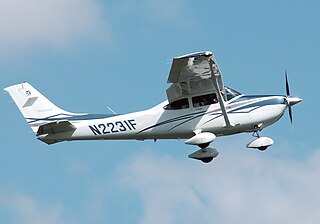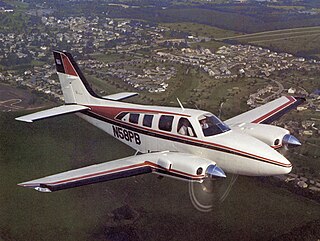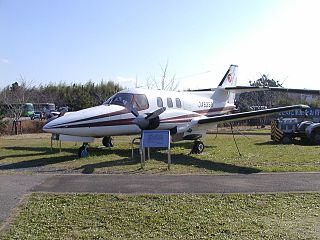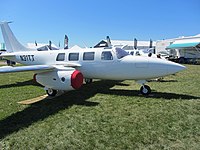
The Piper PA-28 Cherokee is a family of two-seat or four-seat light aircraft built by Piper Aircraft and designed for flight training, air taxi and personal use. The PA-28 family of aircraft comprises all-metal, unpressurized, single piston-engined airplanes with low-mounted wings and tricycle landing gear. They have a single door on the right side, which is entered by stepping on the wing.

The Piper PA-32 Cherokee Six is a series of single-engine, fixed landing gear, light aircraft manufactured in the United States by Piper Aircraft between 1965 and 2007.

The Piper PA-23, named Apache and later Aztec, is an American four- to six-seat twin-engined light aircraft aimed at the general aviation market. The United States Navy and military forces in other countries also used it in small numbers. Originally designed as the Twin Stinson in the 1950s by the Stinson Aircraft Company, Piper Aircraft manufactured the Apache and a more powerful version, the Aztec, in the United States from the 1950s to the 1980s.

The Cessna 182 Skylane is an American four-seat, single-engined light airplane built by Cessna of Wichita, Kansas. It has the option of adding two child seats in the baggage area.

The IMCO CallAir A-9 is a small agricultural aircraft that first flew in 1962, a development of the company's previous successful crop-dusters. It is typical of aircraft of its type - a single-seat aircraft with a low wing incorporating spraying gear.

The Piper PA-24 Comanche is an American single-engine, low-wing, all-metal monoplane of semimonocoque construction with tricycle retractable landing gear and four or six seats. The Comanche was designed and built by Piper Aircraft and first flew on May 24, 1956. Together with the PA-30 and PA-39 Twin Comanches, it made up the core of Piper's lineup until 1972, when the production lines for both aircraft were destroyed in the 1972 Lock Haven flood.

The Beechcraft Baron is a light twin-engined piston aircraft designed and produced by Beechcraft. The aircraft was introduced in 1961. A low-wing monoplane developed from the Travel Air, it remains in production.

The Beechcraft Model 50 Twin Bonanza is a small twin-engined aircraft designed by Beechcraft as an executive transport for the business market. It was developed to fill a gap in Beechcraft's product line between the single-engined Model 35 Bonanza and the larger Model 18. The Twin Bonanza is dissimilar to the Bonanza, being much larger and heavier and using more powerful engines, while in its earliest form having only half the passenger capacity of the Model 18.

The Helio Courier is a cantilever high-wing light STOL utility aircraft designed in 1949.

The PA-25 Pawnee is an agricultural aircraft produced by Piper Aircraft between 1959 and 1981. It remains a widely used aircraft in agricultural spraying and is also used as a tow plane, or tug, for launching gliders or for towing banners. In 1988, the design rights and support responsibility were sold to Latino Americana de Aviación of Argentina.

The Piper PA-30 Twin Comanche is an American twin-engined cabin monoplane designed and built by Piper Aircraft. It was a twin-engined development of the PA-24 Comanche single-engined aircraft. A variant with counter-rotating propellers was designated the Piper PA-39 Twin Comanche C/R.

The Piper PA-34 Seneca is a twin-engined light aircraft, produced in the United States by Piper Aircraft. It has been in non-continuous production since 1971. The Seneca is primarily used for personal and business flying.

The Beechcraft Musketeer is a family of single-engined, low-wing, light aircraft that was produced by Beechcraft. The line includes the Model 19 Musketeer Sport, the Model 23 Musketeer, Custom and Sundowner, the Model 23-24 Musketeer Super III the retractable gear Model 24-R Sierra and the military CT-134 Musketeer.

The Piper PA-31 Navajo is a family of twin-engined utility aircraft designed and built by Piper Aircraft for small cargo and feeder airlines, and as a corporate aircraft. Production ran from 1967 to 1984. It was license-built in a number of Latin American countries.

The Lycoming O-540 is a family of air-cooled six-cylinder, horizontally opposed fixed-wing aircraft and helicopter engines of 541.5 cubic inches (8,874 cc) displacement, manufactured by Lycoming Engines. The engine is a six-cylinder version of the four-cylinder Lycoming O-360.

The Bellanca Viking and Super Viking are a series of single-engine, four-seat, high performance, retractable gear aircraft manufactured in the USA during the 1960s and 1970s. The aircraft developed through modifications of classic designs by the aviation pioneer Giuseppe Bellanca. A total of 1,356 Vikings have been produced with most production between 1968 and 1975.

The Piper PA-36 Pawnee Brave is a 1970s American single-engined, low-wing, propeller-driven agricultural plane built by Piper Aircraft.

The Fuji/Rockwell Commander 700 is a light transport aircraft which was a joint Japanese-American development between Fuji Heavy Industries and Rockwell International. When Rockwell sold off the general aviation division the agreement was terminated.

The Rockwell Commander 112 is an American four-seat single-engined general aviation aircraft designed and built by North American Rockwell starting in 1972. In 1976, they introduced the turbocharged version 112TC and mounting a larger engine with other minor improvements they introduced the Rockwell Commander 114. A total of approximately 1,300 examples of all models were produced before the production line shut down in 1980. In 1981, the type certificate owner was Gulfstream Aerospace, but that company had no interest in single-engine piston production.

The Piper PA-35 Pocono was an American 16/18 seat commuter airliner developed by Piper in the late 1960s. Only one aircraft was built and the design was not developed.



























